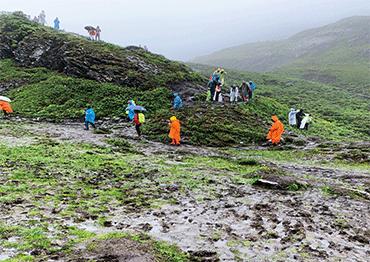This year, He Lichun, director of the Culture and Tourism Bureau of Weixi County and his colleagues have tried to find a way to legalize tourism in Nanjiluo. But these attempts are bogged down amid the unclear responsibilities of different government agencies.
According to He, Weixi County government had a tourism plan for Julong Lake Scenic Spot incorporating Nanjiluo as early as 2003 when the Three Parallel Rivers of Yunnan Protected Areas was listed as a World Natural Heritage Site. The problem is the northern part of Julong Lake Scenic Area is in Deqin County, and it does not belong to Weixi County. According to the Tourism Law of China, Weixi County must get approval from the county government for tourism development.
“When reviewing the plan, Weixi County said it had gone beyond our borders into another county’s territory. So they didn’t grant approval,” He said.
But faced with an influx of tourists and realizing the risks of violating regulations and other safety uncertainties, Weixi County government is trying to prepare a valid plan for legal tourism development in Nanjiluo.
In 2023, He asked a tourism development company in Beijing to compile a General Plan for Nanjiluo Tourism Scenic Area (2023-2035) at a cost of 750,000 yuan (US$106,860).
This time, it only covered the area within Weixi’s domain. In November 2023, officials involved in tourism, ecology, natural resources, planning, water affairs and transportation at the provincial, prefecture and county levels in Yunnan approved the plan.
However, to He’s surprise, he was stymied by more bureaucracy. When the plan was presented to county’s forestry and grassland bureau for the record, He was told there was a problem. Yunnan Provincial Forestry and Grassland Bureau then said that as Nanjiluo is part of a national scenic area, it needs a plan for the scenic area, rather than the tourism plan they had made.
The right to examine and approve plans for scenic spots was transferred from housing and construction agencies to forestry and grassland agencies after a national institutional reform of ministries in 2018. So the plan for Nanjiluo approved by the Culture and Tourism Bureau was completely wrong.
In 2005, the general plan of the Three Rivers Parallel Scenic Area was laid out by Yunnan Provincial Department of Housing and Construction. It was approved by Yunnan Provincial Government before gaining approval from the State Council. It was then approved for implementation by the Ministry of Housing and Urban-Rural Development.
The general plan defines the scope and scale of Julong Lake Scenic area, and specifies that the features of the scenic spot are “characterized by plateau lakes” and that its main functions are for scientific investigation, ecology and cultural tourism.
Yet there has never been any specific plan for Julong Lake scenic area. Professor Kuai said that because the Three Parallel Rivers area spans several prefectures and regions, it is a complex case involving cross-regional governance and cross-regional joint protection. According to Kuai, if a scenic area is within the domain of a county, it can formulate plans. However, since Julong Lake scenic area spans the counties of Weixi and Deqin, it must be done by the next level of government, which is Diqing Prefecture.
Wu Bihu, director of the Research Center for Tourism Development and Planning at Peking University told NewsChina that many areas do not know which agency they should apply to for permission to develop tourism.
“In 2018, the management of scenic spots was theoretically transferred to the State Administration of Forestry and Grassland, but during this period, the Ministry of Housing and Urban-Rural Development proposed different opinions, claiming that scenic spots not only require nature protection, but also cultural protection. The State Council recognized this claim,” Wu said.
He said there was still competing supervision of scenic spots by dual authorities from both the housing and construction department and the forest and grassland agency. These issues must be “straightened out” before the ministerial restructuring is completed, Wu said.
The plan for the Three Parallel Rivers was made in 2005, and it is out of date, Wu said. “At that time today’s popular self-driving and hiking activities were not as common as now,” Wu said.
According to Lu Guoju, Yunnan Provincial Forestry and Grassland Bureau is preparing to update the overall plan for the Three Parallel Rivers area.
Kuai Yanli believes this will be a good opportunity to close regulatory loopholes.
“It’s really necessary to take this opportunity to make blurred boundaries clear and establish which areas can be developed or not. We need to clarify the procedures local governments should follow when developing tourism. System design should solve the contradictions between development and conservation,” she said.
He Chunli still feels helpless. “We don’t have any good solutions now. We’re just waiting for the first heavy snow [to stop tourists coming]. It can’t come soon enough,” he said.

 Old Version
Old Version



